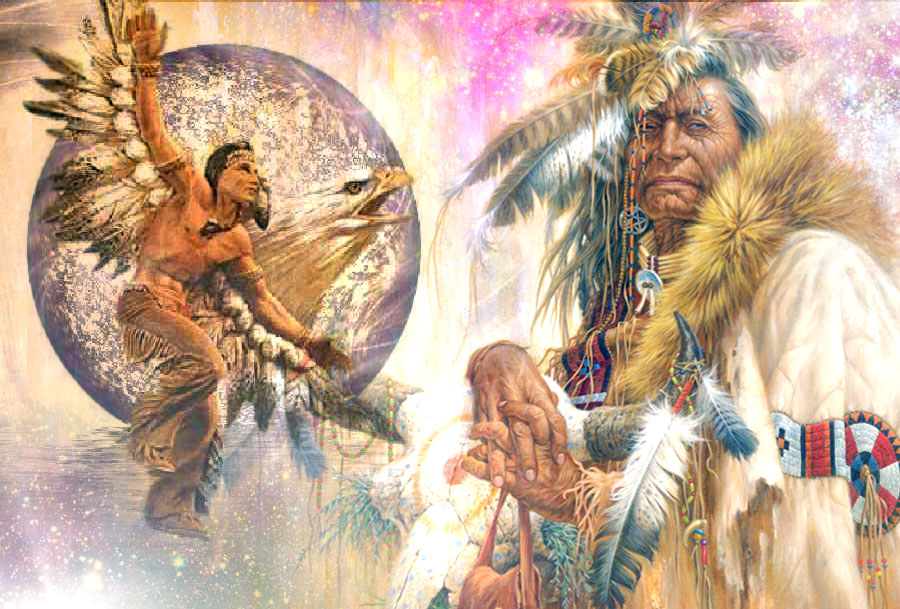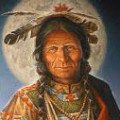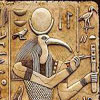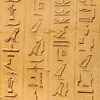Secrets Of The Shamans ~ Part II
 by Vincent H. Gaddis
by Vincent H. Gaddis
In many tribes the medicine men are specialists. One may devote his attention to influencing the weather, another to healing, and still another to assuring victory in battle. With the invasion of the Europeans, a new kind of shaman appeared. His duty was to endeavor to bulletproof the warriors.
Two of the most famous of the bullet-proofers were Chips, the Sioux shaman, and Ice, of the Cheyennes. Chips was known as the Stone Dreamer because he sought his magical powers from stones. His visions and dreams, brought about by fasting and meditations, involved the earth-power inherent in rocks and stones. The stone represented strength and solidity. Many a warrior carried a small pebble given to him by Chips as he went into battle.
In 1857 the Cheyennes received word that hostile white soldiers were headed their way. The warriors asked Ice and another medicine man named Dark to make them bulletproof. Leading the way to the shore of a small lake, the two shamans performed their rituals and sang their songs, meanwhile dipping their hands in the water. When it was over, the pair had a warrior shoot at them at close range as they held up their hands. The spent lead fell from their clothing to the ground.
When the soldiers came, the tribesmen simply stood their ground, waiting, believing that when the soldiers fired they had only to raise their hands and the bullets would fall harmlessly to the ground. Instead of firing, however, the cavalry pulled out their sabers and charged the tribesmen. Several warriors were slashed and the rest had to flee. They ran for several miles before the troopers gave up the chase. The soldiers then proceeded to destroy the Cheyenne village.
It was not war parties but individuals who apparently proved the efficacy of bulletproofing medicine. One of these was Roman Nose, a famous Cheyenne warrior. To gain the magical aura of protection from his enemies, he lay on a raft for four days in the middle of a sacred lake, fasting. His mentor, White Bull, an elderly shaman, made him a war bonnet. Projecting from the headband were eagle feathers, and on the headband itself were sewed part of the skins of a hawk, a kingfisher, a swallow and a bat. Each of these creatures gave the warrior some of its qualities—courage, swiftness, strength, maneuverability. In addition, he never married. This was the “no-woman” medicine which was believed very powerful in battle.
In a battle against white soldiers in September 1865, Roman Nose asked the warriors not to charge or fire until he had ridden before the soldiers and caused them to empty their guns. Riding his white pony, he rode within easy range of the soldiers who were standing beside their wagons. Then he wheeled his mount and rode parallel to their ranks.
The tall, brightly bonneted warrior made a splendid target. The bullets enveloped him like rain. He completed three or four passes back and forth before a ball struck and killed his pony. Roman Nose arose, unharmed, as the warriors launched a charge against the bewildered, awe-struck soldiers.
As long as Roman Nose observed the rituals and the taboos he seemed invulnerable. One of the most important taboos was that the bulletproof warrior must not touch any metal with his mouth. Metal in the form of guns, bullets, knives, swords and hatchets had the power to kill. Before a battle he would not eat with metal spoons or knives.
In the autumn of 1867 the Sioux asked Roman Nose and his Cheyennes to join them in an attack on white scouts. The scouts had been sent by General Sheridan to look for Indian encampments for winter attacks. The whites were besieged by the allied warriors at Beecher’s Island in the Arikaree river in Colorado. Roman Nose was there, but could not take part in the fighting. He had learned that a woman in preparing his food had used an iron spoon. He would not again be bulletproof until he went through purification ceremonies—to take a sweat bath, burn the sacred sagebrush or cedar branches and stand in their smoke. And there wasn’t time for this.
Roman Nose saw his friends and relatives falling in the charges. The chiefs told him courageous deeds and acts of honor would result from his presence on the field. He decided to serve his people without his protection. He led the next charge knowing that he would surely be killed. As he went past the scouts, a shot struck Roman Nose in the back. The end he had foreseen had come to pass.
Sitting Bull was another warrior who understood bullet-proofing medicine. He was a remarkable man in many other ways. He was a mystic who prayed and meditated. It was said that he was under the protection of the buffalo whose name he bore. It was said that he could commune with animals and the birds and that animals could warn him of danger.
In August 1872, the U.S. Cavalry, serving as escorts for surveyors laying out the route of the Northern Pacific Railroad, came into the Yellowstone River Valley in Montana. Sitting Bull and his Sioux tribesmen were camped in the valley, and they resented this invasion of their hunting grounds. A skirmish resulted.
Leaving his horse and weapons behind, Sitting Bull walked casually toward the cavalrymen. When he reached a point about 300 feet from the firing whites, he sat down on the grass, lit his pipe and started to smoke. Bullets whistled over his head and peppered the ground around him. He was a stationary target. From 50 to 80 percent of the men in the western cavalry units were good marksmen, veterans of the Civil War and the various Indian wars. Yet their shots missed Sitting Bull.
When he had finished smoking, he emptied his pipe of ashes, put it into its case and stood up. He walked back to his companions, his back toward the still shooting soldiers. The story of this courageous act was told and retold around western campfires for many years.
The great Crazy Horse too had a reputation for being bullet-proof. General George Crook was an expert marksman both in conflict and as a hunter of deer, elk and bighorn sheep. In the Sioux War of 1876 the General said that he took careful aim at Crazy Horse at least twenty times—and missed.
Crazy Horse, as a boy, went out into the wilderness to fast and pray for spiritual guidance. He had a vision of a warrior riding a horse who fought in many battles but was never harmed. As he fought, a red-backed hawk flew over his head. Yet the man’s own people kept trying to seize him from behind to hold him back.
The dream was explained by a holy man. He said the warrior in the vision was Crazy Horse himself. If he dressed and acted like the dream warrior he would be protected and invincible in battle. But in the end his own people would betray him. So when Crazy Horse became a man, he left his hair loose like the dream warrior instead of braided or tied with fur as was the Sioux custom. In battle he wore a red cape and the stuffed skin of a red-backed hawk on his head instead of a war bonnet. As his dream hero did, he led the charges and was first to strike the enemy. He fought in many battles and never experienced defeat.
When in the spring of 1877 Crazy Horse and his tribe surrendered, it was not because of any military defeat. The buffalo were gone and there was no food. He gave up his freedom because his people were starving. At the Red Cloud Agency in Nebraska, he tried to live in peace. However, the American Indians who had turned to the white man’s ways were jealous of the prestige he held among the Sioux. And the officers and soldiers at nearby Fort Robinson believed that at any time he would go back on the warpath. General Crook especially suspected this.
Crazy Horse was arrested and taken to Fort Robinson. He was told he would not be harmed, but at a hearing the next day he would have an opportunity to deny the rumors that he was planning to continue to fight the white man. They led him to the guardhouse. When he saw the bars, the chains and iron balls on the legs of the prisoners already there, he made a break for freedom. As he started to run, his own people seized his arms and held him. An officer shouted an order to kill the chief and a soldier bayoneted him in the back. He died a few hours later, thus fulfilling the prophecy of his youth.
The North American Indians believed that the Great Spirit have given to all creatures certain outstanding abilities or powers. Some had courage, strength, speed, or cunning. They believed these abilities could be transmitted to those who were mentally or spiritually able to communicate with these animals and birds. Thus the black-tail deer was swift, wary, keen-sensed. He was seldom killed on the game trail since he was protected by living in rough country with abundant vegetation cover.
When one was killed the hunter preserved the entire skin including the head, legs and hoofs. He believed that by wearing this hide in battle he was protected from bullet, arrow and lance. Simply wearing the skin did not provide this protection. The warrior had to pray to the spirit of the dead deer, enlisting its help after performing rituals to contact the spirit.
One of the owners of a protective black-tail deerskin was High Crane, a Minneconjou Sioux. In 1876 in South Dakota an advance unit of General Crook’s army made a surprise dawn attack on a small camp of American Indians. The survivors were driven from the camp into gullies and caves from which the warriors continued to fight. Sitting Bull and Crazy Horse were in another camp at the time, not far distant. A request for help was sent to them.
The two chiefs with about 800 warriors did not hesitate to come to the assistance of the surviving warriors and their families who were now trapped in a cave. This, despite the fact that they had few guns and little ammunition, and would be forced to rely on bows and arrows. The party reached the besieged cave about noon only to discover that General Crook had arrived with the main body of his troops. Now the white soldiers outnumbered the warriors at least two to one. And the soldiers had accurate, far-shooting carbines.
Sitting Bull and Crazy Horse lined up their warriors out of rifle range and a held a council. To charge 2,000 armed soldiers with bows and arrows would be suicide. Since they had wiped out Custer and his men three months earlier, the war had gone against the Sioux. Food was scare and ammunition was short. Then Siting Bull remembered that one of his warriors, High Crane, had a black-tail deerskin with its magical power against bullets.
The chief asked High Crane to ride alone against 2,000 riflemen. The warrior did not hesitate. He pulled the big hide over his body, head over his head, tide the forelegs to his arms, the hind legs to his own legs, then mounted his pony. He rode out in front of the troops. Bullets whined around High Crane and his pony. Bullets plowed the ground and cut the grass over which he rode. He was in the midst of a storm of lead, yet not one pellet touched the warrior or his mount. Within easy rifle range he rode, back and forth, back and forth.
The soldiers and their officers were awe-stricken, utterly bewildered. In the face of High Crane’s tremendous courage and mysterious invincibility, one by one they ceased firing. What weird strategy was this? Were the wily Sitting Bull and Crazy Horse preparing for some other surprise? Orders were given and the line of troops withdrew 500 yards. The next day the troops pulled out completely.
Thus ended the battle of Slim Buttes, in northern South Dakota, in September 1876.
Excerpt from American Indian Myths & Mysteries
See Part I here.
Posted in Other Topics, Spirituality, True History of Manwith comments disabled.





